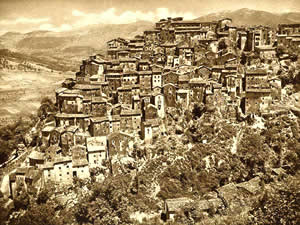

 Hover over the painting to magnify (there may be an initial delay while the magnified image is loaded)
Hover over the painting to magnify (there may be an initial delay while the magnified image is loaded)Charles Cundall (1890-1971):
Dusk, Anticoli Corrado, 1921
Framed (ref: 44)
Oil on canvas
See all works by Charles Cundall oil topography Charles Cundall
Provenance: the artist's wife, Jaqueline Pieterson
Exhibited: - A Working Method,Young Gallery Salisbury, March- April 2016, Sotheran's, April-May 2016.
Literature: Charles Cundall - A Working Method, Edited by Sacha Llewellyn & Paul Liss, published by Liss Llewellyn Fine Art, February 2016.

Knights' first impression of Anticoli conjures up a similar image to
Cundall's painting: 'Anticoli is a glorious place and a little
terrifying, so wild and rugged with huge volcanic mountains all round.
I have never imagined a more beautiful place. It hardly seems real. We
saw Anticoli just springing up out of the precipice like a bundle of
toadstools, all grey houses with green moss covered roofs' (letter to
her mother, XIII, Jan 22 1921).
Cundall's remarkable dusk-time view is painted from the area below the
village where artists rented their studios - Knights described her
studio as 'a joint affair, Nixon, Cundall's (a college man), Miss
Southby's and mine is overhung in one place by a gigantic rock which
hangs by a hair.' The house of Rosa Ceccarelli, where Knights lodged,
with its distinctive loggia, is clearly visible in the centre of the
composition.
We are grateful to Alistair Hicks for his assistance.
 British Impressionists
British Impressionists SOLD
SOLD




